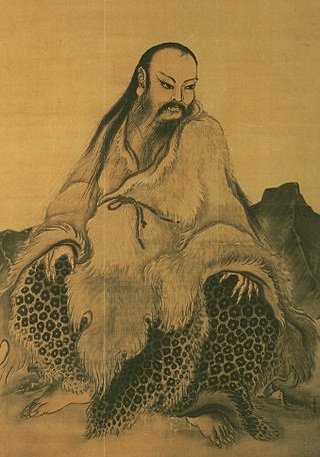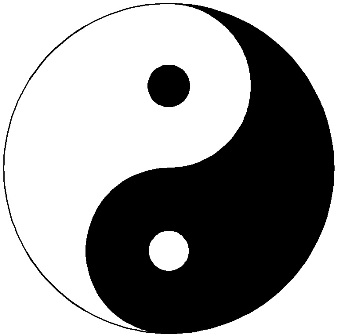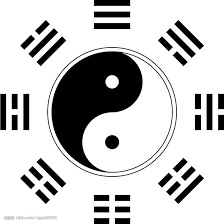Myths and Legends
(3) Fuxi. Creator and Emperor
After Pangu opened the universe, and Gun-Yu (鯀禹) channeled the flood into the sea, the earth became a suitable habitat for the ancient Chinese. Gods and human beings intermingled in heaven and earth in all kinds of activities, sometimes in harmony, sometimes in conflict. Events in the universe were not as defined as we know them today.
Legends were described in many classic books, like Lie Zi 《列子》and Boshu 《帛書》, a piece of cloth unearthed from an ancient tomb.
 Fuxi (伏羲) was one important legendary god-man figure. His birth was an unusual event, and his life a signal contribution to Chinese civilization.
Fuxi (伏羲) was one important legendary god-man figure. His birth was an unusual event, and his life a signal contribution to Chinese civilization.
Long, long ago, in a state called Huashi (華胥國) where people lived happily, without cravings, a girl went for a walk one day. She saw a gigantic food-print on the ground and jumped into it for fun. She became pregnant. Many moons later, she gave birth to a boy named Fuxi.
He was a curious boy, good in solving problems and creating new knowledge and skills. He observed the many changes in heaven and on earth, and created the concept of yin and yang (陰陽), two forces that shape events, in harmony and in conflict. He also created a round figure called  the Taichi Emblem (太極圖), a figure of two perfect parts complimenting one another.
the Taichi Emblem (太極圖), a figure of two perfect parts complimenting one another.
One day, Fuxi stood by the lake to enjoy the wonders of nature. He met an animal with the combined features of a dragon and a horse. They befriended each other. That night he had a dream. It carried him across time and space on a grand scale. His mind flashed with lights and thunders, revealing pictures about human lives. He experienced joy and sorrow, love and hate, hunger and fulfillment, ignorance and wisdom. He also heard music and sounds of silence.
 He woke up at dawn and used a tree branch to draw marks on a sandy ground. As a result he created the Eight Diagrams (八卦). It contains short straight lines like ripples and tides in varying ways. Together they formed a scheme of infinite changes.
He woke up at dawn and used a tree branch to draw marks on a sandy ground. As a result he created the Eight Diagrams (八卦). It contains short straight lines like ripples and tides in varying ways. Together they formed a scheme of infinite changes.
Centuries later, the Eight Diagrams was used in the Book of Changes 《易經》. The diagram was applied mathematically to evolve 68 divinations which combine other factors to make predictions, in life, in business, in politics and fate.
Fuxi grew up to be a practical man, putting aside all his godly powers. He learned how to fish and tame animals. He learned how to grow grains and vegetables. He learned to make fire and used it for cooking. He taught people all that he knew. He and the goddess Nuwa married and brought up four children to become kings to rule all four corners of China.
As a benevolent ruler he was mentioned in Historic Records 《史記》, the authoritative classic of ancient Chinese history. He was mythical by birth and in marriage. He was real in creation, deeds and leadership. He also created the elementary Chinese writing and music, and left us a string instrument which evolved to become the Qin and the Se (琴, 瑟).
 His legacy did not end there. After watching the Yellow River one day, he created the River Scheme《河圖》. It is a square diagram of many dots, some white, some black. Together they formed a mathematical model of many possible calculations, not all of which have been clasped by scholars today.
His legacy did not end there. After watching the Yellow River one day, he created the River Scheme《河圖》. It is a square diagram of many dots, some white, some black. Together they formed a mathematical model of many possible calculations, not all of which have been clasped by scholars today.
Scanty as these narrations of Fuxi may be, his creations and thoughts had inspired many Chinese thinkers, like Laozi and Confucius. They applied much of his understanding of the universe and humans to construct their own thoughts and moral principles.
The Chinese people remember Fuxi as Father of Civilization. Temples have been built in many places to worship him. In 2008, on what was believed to be his birthday, the 18th day of the Third Moon, the Taihao Temple was visited by some eight hundred thousand worshipers from all over the world.
-----------------------------------------------------
Note: This is an English narration of Fuxi, the Father of Chinese Civilization, using the many tales in books like 《列子》, 《帛書》 and 《國語》. He was both god and man. His many creations, scholarly and practical, constitute a major part of the Chinese culture.

